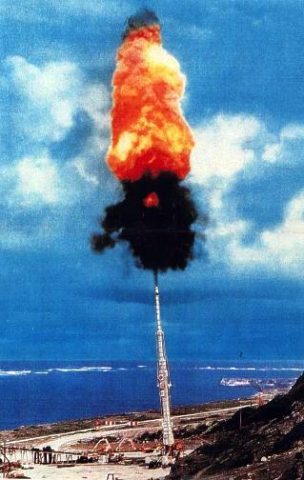
Project HARP - High Altitude Research Project, a joint project of the United States Department of Defense and Canada's Department of National Defence, used a large gun to send projectiles on suborbital trajectories up to altitudes of 180 km (112 miles). Project Persephone's goal of developing equatorial mountain regions for projectile space launch makes Project HARP history and technology a source of lessons and inspiration.
Project HARP conducted studies on upper atmospheric conditions and on the effects of high velocities in the atmosphere, with a series of vehicles called the Martlets.1 The altitudes were above those reachable by balloons, but below those of non-decaying orbits for satellites. Sounding rockets are a more typical way to study such altitude ranges, but they require that most of the mass of the vehicle consist of propellant and motor, reducing the payload mass fraction and increasing the complexity of design, testing, and launch operations. The later Martlet vehicles were composed mostly of payload. The hardening of the vehicle against gun launch stresses (of around 15,000 G) and the requirement of a pusher plate at the base and a sabot to enfold the vehicle while in the gun barrel, exacted a significant mass penalty -- around a factor of two for early Martlet designs, but only about 1/3rd in the Martlet 2G. The main economic advantage of HARP style gun launch was in its relative simplicity and reliability. On a relatively small budget ($10 million, in the early 1960s),2 HARP launched about 200 projectiles, with a near-perfect record of success. Costs (presumably exlusive of projectile costs) were about $5,000 per launch, or under $2 per pound for the Martlet 2G, in 1960 dollars.
Designs of multi-stage solid-fuel Martlets for pushing a payload the rest of the way to orbit suggest that small satellites (~200lb) might have been launched at a cost of around $2000 per pound using HARP technology as a first stage. Project HARP launched from sea level, meaning that the lower atmosphere limited the altitudes it could reach. It also launched from Barbados, which is 13 degrees north of the equator - helpful but not optimal, for using the Earth's rotation as a free source of velocity. If other projectile space launch technologies turn out to be too ambitious for Project Persephone, launching from equatorial mountain regions in the easily-repeated style of Project HARP might still be an option, if the rocket design problems can be solved.
1 Martlet http://www.astronautix.com/lvs/martlet.htm ⇑
This page may have a more recent version on pmwiki.org: PmWiki:ProjectHARP, and a talk page: PmWiki:ProjectHARP-Talk.